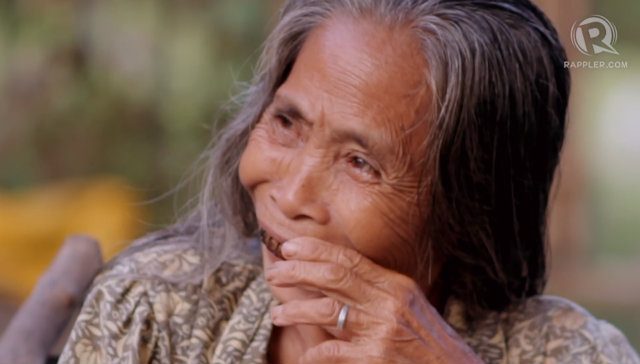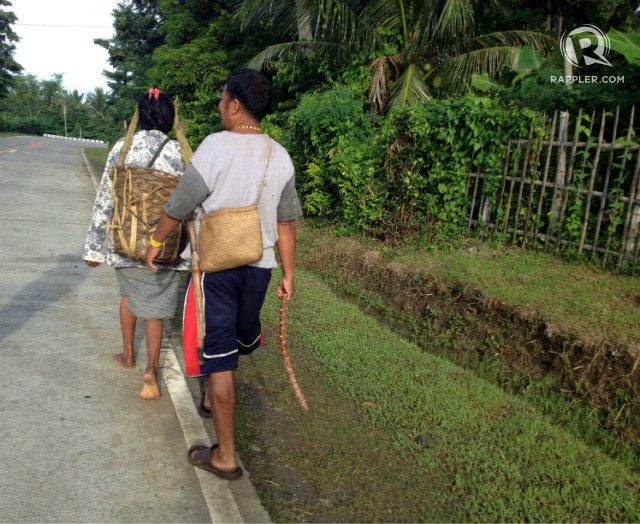SUMMARY
This is AI generated summarization, which may have errors. For context, always refer to the full article.

ORIENTAL MINDORO, Philippines – Minang Sagangsang sat on the bench, waiting for her children to return from school. Her kids are healthy, she said, despite not always having enough to eat.
Many others in her community, however, are not as healthy.
As of 2013, Region IV-B or MIMAROPA had a 35.6% stunting prevalence among children aged 5 and below, higher than the national average of 30.3%, the latest survey from the Food and Nutrition Research Institute (FNRI) revealed.
Stunted children are those too short for their age, resulting from “sustained poor dietary intake,” according to the World Food Program. Stunting has irreversible consequences on one’s physical health and cognitive functioning.
Mindoro is home to the indigenous community of Hanunuo Mangyans, just like Minang. Since they mostly eat rice and root crops, their health might be impacted by such poor food diversity.
Ma. Lilibeth Dasco, an FNRI senior research specialist, stressed earlier that ethnicity should not be a factor during the first 5 years of life since all children need “optimal care and feeding.”
But this does not mean the Hanunuo are not doing their best to care for their children. Hanunuo mothers are considered “strong life-givers and nurturers,” said Professor Susanita Lumbo in a 2010 study published by the Occidental Mindoro State College.
The problem, according to many Hanunuo families, still lies with poverty.
“How? I only finished second grade. The problem is daily expenses. It’s hard to find a job,” shared Minang in her local language.
Education
Minang is a 46-year-old mother of 6. Her day mostly revolves around the field. For additional income, she weaves and makes handicrafts, but her earnings are usually still not enough.
But unlike her parents who discouraged her from studying, Minang pushes her children to pursue education.
“Before, there was no money for expenses. Men were allowed to study since they say women will easily get married. When I was a child, my parents did not let me study because we lived faraway. If they did, I wanted to be a lawyer, it’s good to help the abused,” Minang narrated.
But without scholarships, it would still be hard, said Minang. Her youngest daughter is currently a scholar of the National Commission on Indigenous Peoples. “She’s eager to study even without allowance,” the mother spoke proudly.
Contrary to what some Filipinos might think, Hanunuo children do not always work on the field alongside their parents. If they do, they only help out on weekends. They study during the rest of the week, some Hanunuo parents from Bulalacao said.
Meanwhile, Minang’s niece rested on the foot of their hut. The cool afternoon breeze ran across her warm skin. She is Kathy, a 23-year-old Hanunuo Mangyan. She dropped out of college only a semester away from an education degree.
“No money, so I stopped,” Kathy whispered in her local language. In between coy smiles, she shared her dream of becoming a teacher.
Some of her siblings are already married, while two younger ones are still in school. Although Kathy never experienced discrimination as a child, she still wants to help bust the myth that Mangyans are uneducated. “There are also many Mangyans who finished school,” she said smiling.
“If there’s money, I’ll study again,” Kathy continued. She is the eldest of 8 children.
So are Hanunuo Mangyans aware of family planning? Yes, said one woman leader in Bulalacao, Oriental Mindoro.
“Because if there’s many children, we see among ourselves that it’s difficult to finance their schooling. And of course, [we also think] of the health of the mother, the child, and the entire family,” shared Erlina Sodaye of SAKAHAMA or the Samahang Kababaihang Hanunuong Mangyan (Alliance of Hanunuo Mangyan women).
“Of course if you have less children, you can better take care of your family. That’s what I thought, so I don’t want to have many children,” she continued.
Multiple burdens
“Soil is life,” said most Hanunuo Mangyans, which is why they care for the environment. But extreme weather conditions paired with poverty make it harder for them to always do so.
Ultimately, the burden to feed and care for children while also caring for nature is carried by women.
“As good mothers, they can also become good environmental managers,” said Lumbo, adding that the Hanunuo women’s lives are linked with nature, as they are “knowledgeable of the requites of good environment for their own survival.”
Women’s “lack of viable economic options,” however, may force them to abandon some ecological practices,” Lumbo added. She suggests providing women with better access and control over their land, resources, credit, and education.

Aside from doing household chores, women also have a big role in kaingin, Emily Catapang of the Mangyan Heritage Center told Rappler. In swidden farms, women plant, harvest, and clean. Upon returning from the swidden, they carry the balanan (traditional container). (READ: Signals: Indigenous communities and climate change)
“What men do in swidden farms, women can also do,” Catapang stressed.
“Women weave and make baskets. There are some men who also make baskets, but they don’t weave,” Catapang continued. “As for caring for children, it’s really the women.”
Sodaye hopes Hanunuo women like her get more handicraft orders to help augment their family income.
They are not alone. Across the Philippines, many other women are carrying the same multiple burdens. – Rappler.com
Add a comment
How does this make you feel?
There are no comments yet. Add your comment to start the conversation.